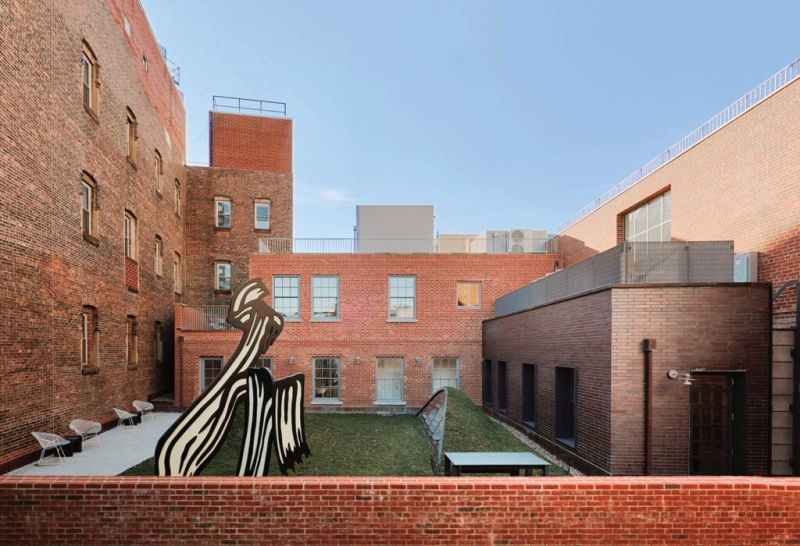Lichtenstein’s Garden Brushstroke, 1996/2009, in painted aluminum on an existing terrace that was replanted and given concrete pavers and a brick partial-height wall. Photography by Max Touhey.
It makes total sense. Transforming the home of a late blue-chip artist into studios for burgeoning artists. That’s what happened on Washington Street in New York, where a 1913 former metal shop was purchased in 1987 by celebrated pop painter/sculptor Roy Lichtenstein and his wife Dorothy as their home and his studio. For the decades following his death in 1997, the site operated as the Roy Lichtenstein Foundation. Earlier this year, it bowed as the first permanent home of the Whitney Museum of American Art’s Independent Study Program. Thanks to a thoughtful preservation, renovation, and expansion by Johnston Marklee—a blue-chip firm in the arts and institutional sectors—vestiges of Lichtenstein’s creative spirit remain as inspiration throughout the now 11,000-square-foot building.
Take the artist studios, which occupy what was Lichtenstein’s studio, his easel system and sink left intact. Their seemingly simple construction of unfinished Douglas fir and plywood make them “durable and raw for artists to inhabit with their work, but they’re also finely crafted,” architect Sharon Johnston explains. Upstairs, inspiration comes from influencers in other fields. The Lichtensteins’ bedroom is now a meeting room outfitted with furniture by Alvar Aalto and Sven Markelius, and a lounge features seating by Frank Gehry and Roland Rainer.

Lichtenstein’s Garden Brushstroke, 1996/2009, in painted aluminum on an existing terrace that was replanted and given concrete pavers and a brick partial-height wall. Photography by Max Touhey.

Johnston Marklee has transformed the two-story former home and studio of Roy Lichtenstein in New York into the permanent site of the Whitney Museum of American Art’s Independent Study Program, adding a third floor to accommodate an artist-in-residence apartment, meeting areas, and this lounge, furnished with Frank Gehry’s Little Beaver chairs that had occupied the Harvard GSD office of and were donated by Mark Lee. Photography by William Jess Laird.

The meeting room’s circa 1930’s Alvar Aalto and Sven Markelius table and chairs, examples of the project’s goal to purchase as little new material as possible. Photography by Max Touhey.

The 15 artist studios in Douglas fir and plywood, Lichtenstein’s wallmounted easel system behind them retained. Photography by William Jess Laird.
